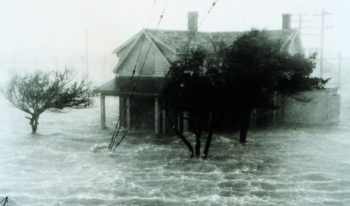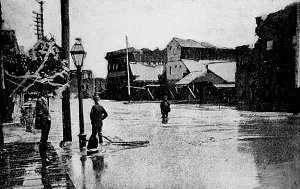Introduction
The case history is based on the hurricane of Galveston, Texas 1900. There was a vicious storm which hit the Galveston Island, killing thousands of the inhabitants, properties destroyed while thousands were left itinerant without homes.
It is considered as the most crucial meteorological event in the United States and the entire world. Storm warnings had been put into place, but the weight of the event was too huge, more than it was expected or thought of.
The storm is considered to lie on the 4th category of the tempest hurricane, and it had been recorded as the tropical storm in Mexico Gulf. Category four of the hurricanes cause extreme damages as what resulted in Galveston.
It destroys the buildings and all mobile structures, those that contain overhanging coverings. It is also responsible for beach erosion and flooding extension to the interior areas far from the sea.
Galveston island description
The island is approximated to be thirty miles long and three miles broad sand islet. Galveston happened to be the prevalent trading midpoint which was the biggest city found in Texas in the nineteen-century endings.
Businesses grew as a result of the port facilities with approximated forty-two thousand number of the populace. The island was tremendously susceptible as it was low-lying approximately just 9 feet higher than the sea altitude.
At the same time, the city had no sea wall which could guard the city on the dangers caused by the sea level rise. The city also had some lower areas. Thus the dunes which are found on the shore were not spared as they were used to fill these lower areas (McComb 1986, 6).
The path of the hurricane
The storm had been already detected by 30th August of the same year from the first signs on the Windward Isle. On the 31st morning, it had moved southwards in an approximate 200 miles to Porto Rico isle.
By on 1st September, it had moved to the Caribbean Sea, and by 2nd it was near Jamaica. On 3rd and 4th September, the storm had moved to Cuba with no descriptive force even though there were cases of heavy rains.
It crossed over Cuba on 5th nearing Key West on 6th with the presence of high winds. The high winds continued on 6th and by 7th afternoon there were heavy swells in Mexico gulf which continued over the night with the unusual rise of the tides.
On 8th September, high winds amplified steadily to the 4th category hurricane in the Galveston city. It was all hell at Galveston when the gulf waters went above the shoreline.
At this point, the efforts of getting into safer shelters were all in vain as people were drowning while those in buildings faced deaths out of wreckages (Muller and Stone 2001).
Damages caused by the catastrophe
The storm is considered as the deadliest catastrophe that ever occurred naturally in the United States historical records. It is approximated that at least 10 to 12 thousand people died during the storm with at around six thousand being from Galveston isle.
This was after the entire gulf was brushed off by waters as the houses which were found close to the beach started to collapse and the timbers which made these houses were pulled out by the strong winds.
Out of the dangers which the residents had experienced, they ran for their safety in elevated parts which were found in the city while some went into stronger buildings. The rescuing process used boats and wagons to take out them that were already stranded in waters.
Bay waters and those from the Gulf met at around 3 p.m, as the entire city became submerged. The wind brew at speed referred to as cyclonic velocity which left the roofing, telegraph posts, and other structures falling with the terrifying noise which came from the wind as well as the crashing of structures.
Everything was brushed off by the winds whereby 4 p.m up to around midnight, the raging hurricane was very furry. An approximated amount of twenty-five to fifty thousand U.S dollars was worth the properties that were destroyed.
Buildings that did not collapse were damaged in one way or another, where it was hard to find any dry house which was habited in the city.
At this point, it cannot be approximated at which the heights had the winds arrived at as the instrument had also been carried away by the wind and the waters (Grace 2010).
Environmental issues and geology
The storm preceded the sea level rise which is known to have caused the flooding in Galveston. Due to the sea level rise that led to flooding, the shoreline was eroded as well as the beaches. The storm surges were very high in that it ended up sweeping all the properties.
Even though there were signs of the storm, the effect of the disaster could not be predicted as Galveston had been got used to storms, but the unrealistic expectations became real.
There was no sea wall which could have prevented the flooding to over flooding in the city, and the shore and had already been eroded.
Storm effects after 8th September 1900
On 9th at around 8 a.m, the wind had already diminished in its speed at a relatively moderate rate of 32 kilometers per hour of the hurricane force which was present on 8th evening.
Even after winds diminished from the hurricane force, the storm went on its vicious conduit into Texas as it crossed into southern plains and later re-curving into Great Lake.
On 12th and 13th of September, it arrived at the Atlantic Ocean. On leaving Texas, it moved to Minnesota, Michigan then into Newfoundland. By 13th September, the storm curved on the way to Scandinavia where it finally died (Muller and Stone 2001).
Conclusion
After the Galveston hurricane, a seventeen feet high seawall was built exceeding mean low wave and tide where there was an extension of the protective barrier.
The ground which is across seawall was inclined by 5 feet elevated above the inland side compared to the concave surface which is found at the top. The slope is very significant as it breaks action waves that make their way to the top of the seawall.
The entire city was also raised, which involved the raising of the city structures. After the destruction of the city, it was hard to regain its position of the commercial setup, but still, it holds the fashionable tourist desirability and attraction at the same time it holds a key ship port.
The 1900 hurricane experience in Texas held up significant position on the responses which were made after it. It was a historical event that left a mark as even after a period of more than one hundred years; it seems that it is fresh to the historians as though it happened a few years back.
Reference List
Grace, Ernestine E. 2010. The Galveston, Texas 1900 Storm, Lee L. Lowery, Jr., PhD, P.E. Web.
McComb, David G. 1886. Galveston: a history. New York: University of Texas Press.
Muller, Robert A. and Gregory W Stone. 2001. “A Climatology of Tropical Storm and Hurricane Strikes to Enhance Vulnerability Prediction for the Southeast U.S. Coast.” Journal of Coastal Research 17(4): 949-956.
Figures

